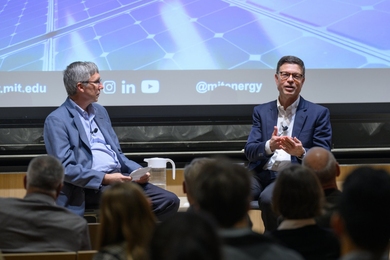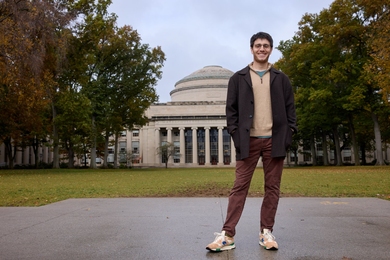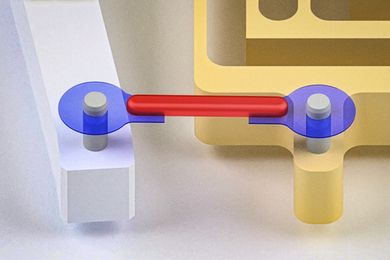Honoring her more than 20 years of significant contributions to Massachusetts science education, the Massachusetts Association of Science Teachers inducted Kathleen Vandiver into its Hall of Fame for Science Educators at the association’s annual conference in November. Vandiver, director of community outreach and education programs for the MIT Center for Environmental Health Sciences (CEHS), helped to create engaging ways to teach abstract scientific concepts, such as molecular genetics, with models made from familiar LEGO bricks.
“It isn't just that I make models,” said Vandiver, who taught sixth-grade science in Lexington, Mass., from 1990 to 2005. “What's different is I design the projects so that the models and lessons intrinsically emphasize the key concepts instead of all the details. And it's helpful for students to engage with the point of the lesson in a tactile, memorable way.”
Vandiver continues to explore how to make abstract concepts clear to students. A recent exhibit in the MIT Museum, "Learning Lab: the Cell," used LEGO bricks put together by the participants to emphasize the connection between DNA and health.
In an MIT Edgerton Center project — funded in part by NASA and supported by CEHS — Vandiver is currently collaborating with the Boston Public Schools science department to pilot the hands-on LEGO DNA curriculum in biology classes, and to provide teacher professional development sessions and classroom support. The project, began in May 2010, was implemented last spring and continues this year. The materials are very popular with teachers and students, and especially English as a Second Language (ESL) students.
Marilyn Richardson, a teacher who nominated Vandiver, first met her at an MIT CEHS teacher summer workshop in 2007. Marilyn said, “I hadn't taught life science in many years and working with the LEGO kits helped me refocus on biological issues and helped me do a better job of teaching.” Sixth-graders and AP biology students alike are picking up the concepts, as well as adult learners such as nurses, engineers and judges, corroborating that the models embody universal design principles. Different LEGO sets have been created to address the fundamentals in DNA, proteins, protein synthesis, cell division and chromosomes, and chemical reactions such as photosynthesis.
Vandiver was pleased to be recognized for creating tools for hands-on learning, and noted there are many worthy and deserving teachers in Massachusetts whose work we appreciate and wish to honor.
“It isn't just that I make models,” said Vandiver, who taught sixth-grade science in Lexington, Mass., from 1990 to 2005. “What's different is I design the projects so that the models and lessons intrinsically emphasize the key concepts instead of all the details. And it's helpful for students to engage with the point of the lesson in a tactile, memorable way.”
Vandiver continues to explore how to make abstract concepts clear to students. A recent exhibit in the MIT Museum, "Learning Lab: the Cell," used LEGO bricks put together by the participants to emphasize the connection between DNA and health.
In an MIT Edgerton Center project — funded in part by NASA and supported by CEHS — Vandiver is currently collaborating with the Boston Public Schools science department to pilot the hands-on LEGO DNA curriculum in biology classes, and to provide teacher professional development sessions and classroom support. The project, began in May 2010, was implemented last spring and continues this year. The materials are very popular with teachers and students, and especially English as a Second Language (ESL) students.
Marilyn Richardson, a teacher who nominated Vandiver, first met her at an MIT CEHS teacher summer workshop in 2007. Marilyn said, “I hadn't taught life science in many years and working with the LEGO kits helped me refocus on biological issues and helped me do a better job of teaching.” Sixth-graders and AP biology students alike are picking up the concepts, as well as adult learners such as nurses, engineers and judges, corroborating that the models embody universal design principles. Different LEGO sets have been created to address the fundamentals in DNA, proteins, protein synthesis, cell division and chromosomes, and chemical reactions such as photosynthesis.
Vandiver was pleased to be recognized for creating tools for hands-on learning, and noted there are many worthy and deserving teachers in Massachusetts whose work we appreciate and wish to honor.






